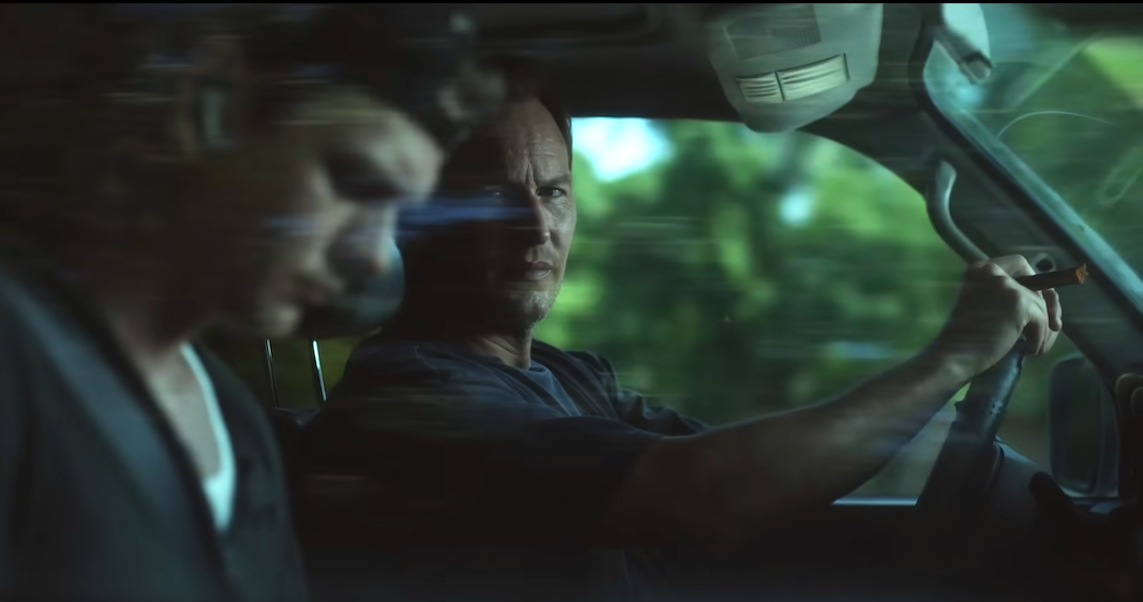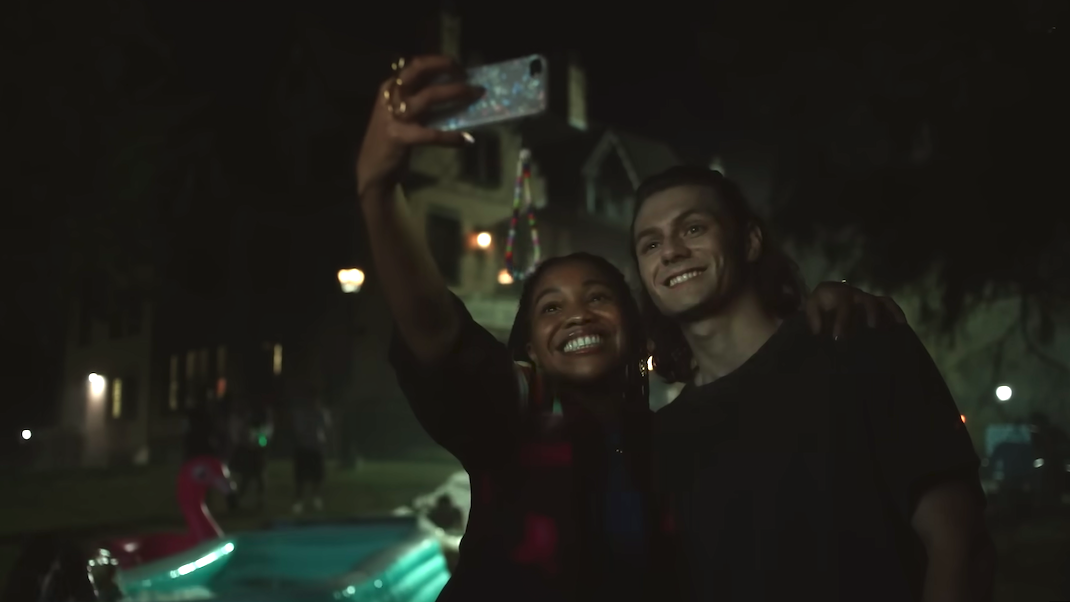Insidious: The Red Door is part of My Summer of Summer Movies, in which I am attempting to see and review every movie that opens (in Chicago) between Memorial Day and Labor Day, 2023. Read all about this ill-advised plan here.
So I have committed to reviewing everything that comes out this summer, but what is there to say about Insidious: The Red Door? There are approximately 147 indistinguishable films in the extended James Wan-created horrorverse, which includes the Insidious movies (this is number five), and the Conjuring movies (three and counting), as well as Conjuring spin-off franchises Annabelle (three movies and a stand-alone tie-in film) and The Nun (one movie so far, with another coming in September).
Patrick Wilson is in most of these movies, which apparently makes him—through sheer osmotic fluency, if nothing else—qualified to direct this one. (He plays one character in the Insidious franchise, and another in The Conjuring movies and their assorted sequels and spin-offs.) And they're all about a group of relatively innocent people—usually a family, sometimes some nuns and/or orphans—who come under attack from demonic entities that terrorize them by lurking and opening doors and making really loud noises. The demons are eventually dispatched by some sort of paranormal investigator/religious figure, until they're ready to come back for the sequel. (Sometimes, for novelty, we get a prequel, to find out just how the demonic figure got so damned demonic in the first place.)
Honestly, if you've seen one of these movies, you've seen them all, and you either like them or you don't. As it happens, I don't. And, since they all share such a basic template, I feel like I should be able to use a similar template any time I have to review one. So here's some proposed boilerplate, drawn from the one such film I have written about previously, 2017's Annabelle: Creation:
British film critic Mark Kermode calls this particular sub-genre "cattle-prod cinema," or "quiet, quiet, quiet, BANG!" movies. They are "films" purely in the academic sense: really, they are amusement park haunted-houses in celluloid form, constructed purely to manufacture cheap and meaningless jump-scares. […]
Horror can be an incredibly effective medium for making us question things that need to be questioned, but all [INSERT FILM NAME HERE] wants to do is make you question where the next loud bang is coming from. These sorts of films strip out everything that makes the horror genre worthwhile, leaving just an efficient machine for generating instinctual flinches. So—if that's what you're into—you can expect to jump throughout [INSERT FILM NAME HERE]. You could also reliably expect to jump if I had you sit in a dark theater for 90 minutes, while I crept around silently, leaping out every few minutes to throw an angry cat at your head. If that sounds like fun to you, more power to you—but let's not mistake such a cheap and fleeting sensory experience for anything real or meaningful.
That says basically what I have to say about these movies, and it is tempting to leave this review right there. However—though all of that is absolutely applicable to Insidious: The Red Door—I suppose the spirit of my review marathon demands a bit more engagement.
For the record, I am dedicated to the process. I dutifully watched Insidious (2010) and Insidious: Chapter 2 (2013) in the week leading up to the release of Insidious: The Red Door, so I could have the necessary back-story. (I did not watch the third and fourth films in the franchise—Insidious: Chapter 3 (2015) and Insidious: The Last Key (2018)—which are apparently loosely-connected prequels. There's a fine but important distinction between dedication and masochism.)
Insidious introduced us to the Lambert Family: father Josh (Wilson), mother Renai (Rose Byrne), eldest son Dalton (Ty Simpkins), and two additional children who disappear completely from the plots of all three movies unless they are called upon to scream. As we come to find out, Josh and Dalton share an unconscious talent for astral projection: their souls tend to go dream-walking in a spooky realm called The Further, a habit that unfortunately leaves their bodies as empty and tempting properties for dead souls and demons to come and squat in.
The first film found young Dalton leaving his body so completely that he fell into a long coma, while various spooks menaced his family hoping to claim the boy's abandoned form. In the second chapter, it was Josh who accidentally went on ethereal walkabout, enabling a dead serial killer to wander in and run amuck in Josh's body. At the end of Chapter 2—in an effort to prevent them from continuing to leave their psychic cat-flaps open—Josh and Dalton agreed to be hypnotized, to remove all memory of these events and their dangerous extra-corporeal abilities.

Now The Red Door picks up with these character nine years later. In the intervening years, Renai has done what she should have done five minutes into the first movie, and divorced Josh, who has become mentally foggy, emotionally distant, and spiritually disheveled over the past few years. Dalton is now a surly and sullen teenager, about to enter his freshman year of college. Hoping to heal the estrangement between them, Renai suggests that Josh drive Dalton to school, providing them with a two-day road trip and bonding opportunity neither of them remotely wants.
And it is here in my screening of The Red Door that my frustrations with the limitations of these movies first returned (never to depart). Having established the father-son relationship as the foundation and stakes of the film, and having carefully arranged to put Josh and Dalton together in a car for two days, the film jumps to their pulling up outside Josh's university, eliding the entire trip. Did father and son talk about their past and their current issues? Did they compare notes on their shared missing memories? Did they argue about what to play on the radio and which drive-through restaurants to hit? We don't know, and neither does the film: it is not really interested in its people as characters, only as fodder for jump scares—and it's hard to stage repeated jump scares in a moving vehicle. For the bulk of the film's running time, Josh will go home to his late mother's house, and Dalton will wander his strangely empty college dorm, where various apparitions can occasionally jump out and menace them each individually.

Simpkins was a decent enough child actor—he was quite entertaining in Iron Man 3—and it would perhaps be unfair to comment on his acting abilities as a grown man based solely on his performance in this joyless and underwritten role. I will say, however, that Dalton—now a brooding art student—is both boring and boorish. So it is a good thing his storyline—which involves suitably collegiate paranormal encounters like an incessantly vomiting ghost—are enlivened by a manic-pixie partner named Chris (Sinclair Davis). To be clear, Chris—a female student accidentally assigned as Dalton's roommate—makes no sense as a character. (Neither my horror-hating wife, nor horror-savvy characters like those in Get Out or The Blackening, would ever countenance a smart Black woman who is so eager to involve herself in this White man's nocturnal nonsense.) But Chris is the only likable person in the movie, and she brings the film a few desperately needed moments of humor and energy. (Between Simpkin's sullen sinkhole of a character, Wilson's placid, mashed-potato presence, and Byrne's brief, contractually-obligatory appearance, Davis seems like the only person on the film's set who actually showed up to work and have fun.)
My general philosophy as a critic is to judge each film by how well it does the thing it sets out to do. So it is perhaps both pointless and churlish to complain that Insidious: The Red Door has nothing to say. Seemingly aware that horror works best with some thematic purpose, screenwriters Leigh Whannell and Scott Teems feint towards notions of generational trauma and the novel proposition that keeping secrets in families is bad. ("We need to remember even the things that hurt," Dalton will offer as a lesson, near the end of the movie.) But the traumas of this particular family are so specifically, stupidly weird that they don't serve as a useful metaphor for anything real, and the characters are so underdeveloped—even after three-to-five movies—that we can neither invest in their salvation nor learn anything from it.
Which leaves us with nothing but "quiet-quiet-BANG" as a mission-statement, and so the only useful review is to comment on whether or not Insidious: The Red Door is scary. Wilson's direction is as competent as the material deserves, but he lack's even Wan's shallow but effective flair for an unnerving or unexpected shot: the scares pretty much come exactly where we expect them, and they are usually less imaginative than we hoped, meaning nearly all of them register as anti-climactic disappointments. In the interest of full disclosure, I will confess that The Red Door made me jump a couple of times, but that's no particular accomplishment. If you suddenly flash a demonic figure on the screen, and crank the volume from 0 to 100+ decibels without warning, you can make the audience flinch where you want them to flinch.
But the film is not scary in any way that matters. Great horror, of course, needs to mean something beyond its own machinations. But even horror that only aspires to be entertaining has to build suspense—not just startle—and make me care about the characters as more than funhouse manikins. On this front, Insidious: The Red Door fails completely, making it the poorest, most pedestrian entry in an already lackluster franchise.
